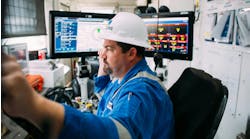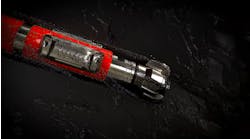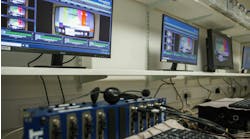Drilling the North Sea's most extreme horizontal section
Drilling fluid design critical for Kingfisher well
Transocean Integrated Services had managed the drilling and completion of four wells in the Kingfisher field, which is operated by Shell UK Exploration and Production on behalf of Shell and Esso. The first three wells were all within normally pressured Brae Sandstone, but the fourth well - 16/8a-K6 - was to be the deepest horizontal well drilled in the North Sea. This and other operating parameters such as high temperature and pressure gradients close to formation fracture gradients, made this well the "most extreme" well drilled in the North Sea.Reservoir conditions (pore pressure, temperature and effluent gradient) meant that 16/8a-K6 lay just outside the industry standard definition of a HP/HT (high pressure/high temperature) well. However, to overcome the challenging nature of the project, the decision was made to treat the well as if it actually met recognized HP/HT criteria. At first this appeared to be wasteful over-specification, but completion of the drilling 25 days ahead of schedule suggests otherwise.
One of the principle advantages of adopting the HP/HT approach was that the project was no longer regarded as being on the frontier of normal well conditions. Instead, Kingfisher 16/8a-K6 became a well that simply required meticulous planning, careful selection of materials, and adherence to a set of established standards common to all HP/HT wells. There is no magic attached to successful HP/HT drilling; it is just a case of good practice - but with no room for error.
The well
The project involved drilling a 3,000-ft horizontal reservoir section at a vertical depth of over 15,000 ft, with an overall lateral displacement of over 6,000 ft. The drilling window was tight. The operating margin between pore and fracture pressure - which at less than 800 psi, was actually smaller than most true HP/HT wells.The rig used for the well was the Transocean John Shaw, an Enhanced Pacesetter harsh environment semisubmersible which had already drilled the previous three Kingfisher wells. As the rig was not specified to meet recognized HP/HT standards, a technical audit was carried out to identify the upgrades and procedures that would be needed for the project.
As it was not intended to upgrade the rig to full HP/HT capability for just one well - the maximum expected wellhead pressure for 16/8a-K6 was 9,300psi - the 10,000psi BOP was retained. Consequently, the rig modifications required for the Kingfisher well were limited to only minor equipment upgrades and procedural developments.
The procedures needed to be based primarily on sound engineering practices, and also understood and adhered to by offshore crews, and all connected with the project. To ensure competency, HP/HT schools were organized for the drill crews, service company supervisors, and the onshore and offshore management teams. These were complemented with a pocket-sized booklet with bullet points and checklists, distributed to all rig personnel.
The most important step in drilling a section with a narrow drilling window is "finger-printing" the wellbore. Time spent at this stage can be repaid many times over. In the case of 16/8a-K6, finger-printing contributed significantly to the overall saving of 25 days. By establishing and constantly updating baselines of fundamental data, anomalies could be quickly identified and addressed.
Two sets of procedures were used during the drilling and completion of the horizontal section. The first set, more conservative and time-consuming, was in place from the start and formed the basis of the crew training / familiarization program. Once the transition zone had been drilled and the reservoir entered, the very stable nature of the wellbore prompted the introduction of a second, less stringent, set of procedures. These procedures had been planned to allow quicker progress once the crew had gained experience in what was required and it was clear that the potential loss/gain situation was under control.
Technology selection
Planning and adherence to procedures can limit the probability of human error leading to delays or complications, but it is also vital that the best technology is deployed and optimized. One element that was particularly crucial to success was drilling fluid design.HP/HT wells are generally more difficult to drill than normally pressured wells due to their narrow drilling window. In comparison with a vertical HP/HT well, a horizontal HP/HT is even more difficult due to the increased equivalent circulating density (ECD) for a given operation. For the 16/8a-K6 well, it was decided to chose the Ultidrill mud system, which had already been proven in higher pressure and temperature environments than those of the Kingfisher well (Shearwater project).
To assess the implications of the higher ECD, comparative simulations between a vertical HP/HT and the profile of well 16/8a-K6 were produced using Dowell's Hydraulics Program Dshyd. The results of the simulations indicated that where the hole angle is low, the ECD of the Kingfisher well was similar to the ECD of any other vertical hole. However, once the drill bit entered the horizontal section, the ECD for 16/8a-K6 becomes significantly higher under the same pump rate and drilling conditions.
The Dshyd simulation illustrated that horizontal HP/HT wells are the most challenging type of well, as they experience both a reduced drilling margin and an inherently higher ECD, which continues to rise as the horizontal section gets longer.
Overcoming the challenge of increased ECD required an understanding of how mud rheology affected it. Standard industry practice dictates that PV and YP should be maintained below a certain maximum level to minimize the ECD. Consequently, the norm is to over-specify, whenever PV and YP are above specification. However, experience with the Dshyd simulations shows this practice to be flawed.
Using the PV and YP to calculate the ECD provides a misleading result, as the shear stresses on the annular walls are over-estimated, and yields an unrealistically high estimation of ECD. In general, if relying on PV and YP, the more shear thinning of the fluid, the higher the error would be. For high shear thinning water based mud systems, the annular pressure loss can be over-estimated by over 100% using PV and YP. A more accurate calculation of ECD can be obtained by using low-shear rate rhelogy.
Rhelogy control
The simulations carried out using Dshyd for Kingfisher 16/8a-K6, led to the adoption of low-end rhelogy as the principle tool in predicting ECD and the effects it would have on the drilling program. In fact, with the experience of the Kingfisher well, the overall philosophy of fluid engineering for Transocean Integrated Services has now changed from control of PV to controlling the low-end rhelogy.Experience with the Heron and Shearwater projects demonstrates that the equivalent downhole mud weight could be significantly different from the surface mud weight - particularly if the flowline or active pit temperature is high. Due to the importance of ECD for this project, it was decided that procedures developed during the Heron project, along with analysis from the Dyshd program and the pressure-while-drilling (PWD) tool, should be applied to monitor and control surface mud weight.
To obtain a better understanding of the hydrostatic pressure and the ECD, a PWD tool was run during the entire HP/HT section of the project. The tool provided continuous measurement of ECD and occasional readings of hydrostatic pressure to ensure that the ECD was kept below the fracture gradient and that adequate hydrostatic overbalance was maintained. Drillers were given ECD "hard lines" to remain within. Drilling parameters used by drillers to control the ECD were reduced flow rate and pipe revolutions per minute (RPM). Mud circulation to clean the annulus and condition the mud were both also used to reduce ECD.
Pressure while drilling
The PWD tool also provided a valuable confirmation of the predictions obtained from the Dyshd program, which was originally verified using PWD data obtained during the Shearwater project. After displacing the well to 810 pptf mud, the 9 5/8 in. shoe track and 15 ft of new formation were drilled and the mud was circulated even. Then, a formation integrity test was carried out to 858 pptf equivalent mud weight based on the PWD reading. Surface mud weight was calculated at 802 pptf at 125°F, and based on the PWD data, the equivalent downhole mud weight came to 814 ppft - an exact match to the Dshyd prediction.The Dowell program also was used to calculate that if the surface mud weight was measured at 91°F, it would be exactly the same as the equivalent downhole mud weight at the top of the reservoir. Therefore, 91°F was defined as the standard mud temperature for surface weight control.
Other technology used for this well included tailor-made PDC bits, designed to balance the requirements for steering versus ROP and longevity, through the well's extremely hard formations and "logging-while-fishing" - which was a first.
The future
Drilling assemblies used for the horizontal production hole section consisted of two bit runs - the first being a conventional steerable motor and PDC bit. This assembly failed to drill due to excessive drilling torque generated by the PDC bit, making tool face orientation difficult. The second assembly completed the production hole section and consisted of a steerable turbine assembly and PDC bit. Steering parameters included 66% orienting and 33% rotating times during the build section of the production hole.Kingfisher 16/8a-K6 was completed with no drilling-related problems throughout the entire HP/HT section and the well was drilled to a terminal depth without having to set a 7 in. liner. This meant a savings of 24.85 days. Later, over 3,000 ft of 4 in. by 7 in. liner was run, set, cemented and tested in the horizontal HP/HT reservoir section, again without problems.
The success of this project is proof of what can be achieved with careful assessment of the task and precise detailed planning. By making things as simple as possible, predicting and accounting for any potential problems and taking things one step at a time, the most extreme horizontal well in the North Sea became a relatively straight forward project rather than a risky venture.
Acknowledgement
Bob Fennell, Manager Transocean Integrated Services, was a substantial contributor to this article. The authors would like to thank Shell UK Exploration and Production for allowing publication of this information.
Copyright 1999 Oil & Gas Journal. All Rights Reserved.


